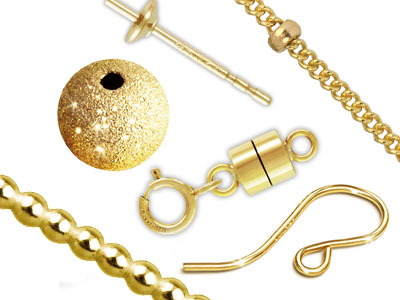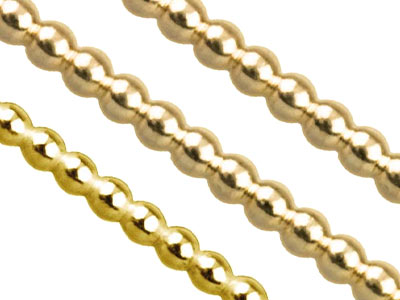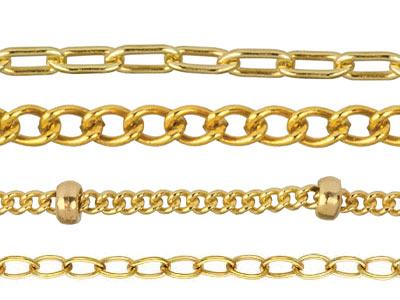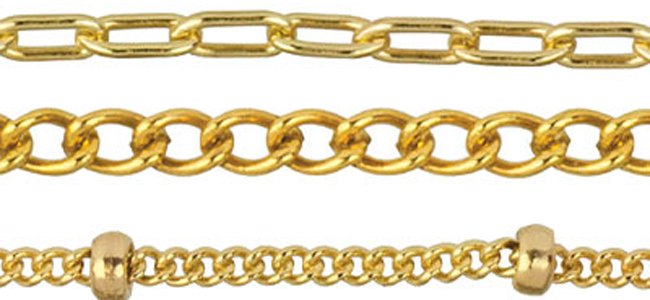Many jewellery makers find gold filled jewellery new and sometimes intimidating if they feel unsure about it. You may have plenty of questions about this metal and how to work with it. That’s why we created this blog—to answer your questions and help you understand gold filled jewellery. By the end, you’ll feel more confident with the alloy and ready to make your own gold filled creations.
What is gold filled jewellery?
You may be wondering: what is gold filled jewellery, and how does it differ from solid gold or gold plated jewellery? People also refer to gold filled as “rolled gold” or “gold bonded.” Manufacturers create it by mechanically bonding a layer of gold to a base metal core, usually brass. They apply heat and pressure to fuse the gold to the brass, forming a permanent bond that prevents the gold from flaking, peeling, or falling off.
By law, a gold filled item must contain at least 5% (or 1/20) gold by total weight. If the gold content falls below 5%, the item no longer qualifies as gold filled. In comparison, most gold plated items contain less than 0.05% gold by weight.
There are three different possible ways to layer the gold alloy to create gold filled jewellery:
- Single clad – Gold is layered only one side of the brass, the whole 5% is on one side
- Double clad – Splits the gold alloy and layers it on both sides of the brass, 2.5% each side meaning a thinner layer
- Wire clad – the 5% gold alloy content is layered around the entire wire
Choose gold filled items if you want a material that offers higher quality than gold-plated but costs less than solid gold. With proper care, gold-filled pieces can last a lifetime and resist damage from water or hot weather. Under normal conditions, they won’t tarnish. Use gold filled findings for riveting, stamping, and light metalwork, such as hammer texturing. You can craft beautiful gold-filled creations for friends, family, or your customers.

How do I solder gold filled material?
Since solder itself is an alloy of metals, there is no such thing as a gold filled solder, so a colour match needs to be done. We recommend either 9ct or 14ct yellow gold easy solder as good colour matches.
Take extra care when soldering gold filled material. Overheating the metal can cause irreversible damage and create “restain,” a type of subsurface rescale that can penetrate the entire gold layer.
When you use a torch to solder gold filled products, watch out for another issue: alloying the gold layer with the brass core. This reaction leaves a dark, discoloured solder joint, and any exposed brass will tarnish quickly. To avoid this, heat the piece only to the point of solder flow—between 690°C and 788°C. Do not overheat to the melting points of the 14ct gold layer (843°C) or the brass core (around 900°C).
If you notice colour mismatch or exposed brass, restore the piece by gold plating the entire surface. Plating adds a uniform gold layer, hides discolouration, and protects exposed brass from tarnishing. For best results, finish all soldered gold filled creations with gold plating.
Can you cut gold filled creations?
If you need to cut gold-filled material, take great care not to scratch or damage the gold layer. If you expose the brass core, cover it to prevent tarnishing. You can use gold-plating to coat any exposed edges. Cutting away part of the gold layer also changes the ratio of gold to brass. The law requires gold to remain at least 5% of the piece’s total weight.
How do I store my gold filled creations?
Use tissue paper between each gold-filled piece during storage to prevent scratches. Scratches are hard to remove without exposing the brass. Cover your work surface with a clean cloth while handling gold-filled material to protect it from damage caused by your bench pin or other hard edges. Since tarnishing elements act slowly without moisture, always store gold-filled jewellery in a dry place.

How do I clean and polish my Gold-filled items?
Cleaning your gold filled creations is extremely simple—just avoid using anything that could scratch the surface. To craft the best gold filled jewellery, make sure you can keep each piece sparkling for your friends, family, and customers. Here are four ways you can clean gold filled items:
- Use mild soapy water or a mild detergent with a soft toothbrush to remove residue or fingerprints effectively. This method keeps the finish bright and shiny.
- Soft cotton cloth: Any clean and soft cotton cloth is perfect to polish your gold filled creations to a shiny finish. There are also jewellery polishing cloths specialised for exactly this, such as Towntalk microfibre cloths. However, some may contain chemicals that are not recommended on gold filled jewellery, so ensure that they are suitable. Do not leave chemicals on your gold filled creations, rinse and polish again with a soft cloth.
- Use an ultrasonic machine to clean items quickly and effectively. Check the pieces every two to three minutes to avoid overexposure. Always confirm that your cleaning solution is safe for gold filled jewellery. When finished, rinse each piece with water and dry it using a soft cloth.
- Tumbler Machine: Tumble finishing can also be done to polish your gold filled creations. We recommend using stainless steel shot, as it’s non-abrasive and will not remove the gold layer.
Gold filled vs. gold plated
So, what’s the difference between gold plated and gold filled? We can help with that. Here are a number of differentiating factors between the two:
- Gold value: Gold plated jewellery has no gold value, whereas gold filled jewellery has 5% gold value.
- Manufacturing process: This is much more complex with gold filled jewellery, where the alloy is bonded to the inner core using heat and pressure.
- Tarnish: Gold plated jewellery is much more likely to tarnish, react with the wearer’s skin and lose its shine before gold filled jewellery.
How long does gold filled jewellery last?
Looking for jewellery supplies that will last? You’re in luck. If you opt for gold filled jewellery as opposed to gold plated, it should last somewhere between 10 to 30 years. What’s more, it costs a fraction of the price of high carat gold pieces. It’s a win-win!
Does gold filled jewellery tarnish?
Does gold filled jewellery tarnish? In most cases, gold filled jewellery will not tarnish. However, there are a few certain circumstances where it could happen. These rare instances include transit through polluted locations, exposure to chemical sulphide fumes and fire damage.

Things to consider when creating gold filled jewellery
Don’t
- File or cut into a gold filled product, as it will reveal the brass under layer.
- Over polish as this will reduce the thickness of the gold layer.
- Wear next to harder, more abrasive metals (such as steel) for prolonged periods as this will wear away the gold layer.
- Spray perfumes or hairspray as this will increase the risk of tarnishing.
- Try to cast using gold filled metal.
Do
- Solder using 9ct or 14ct easy solder.
- Polish gently to help maintain the gold layer.
- Mix with similar, softer metal components (e.g. silver) to minimise wear.
- Offer gold-filled options to customers to maximise look but lower the cost.
- Discuss the gold content of the metal with customers because not all gold-filled products are created equally and not everyone will be prepared to disclose this information.
See our selection of the best gold filled jewellery or projects to start creating your very own gold filled creations.

Cooksongold

